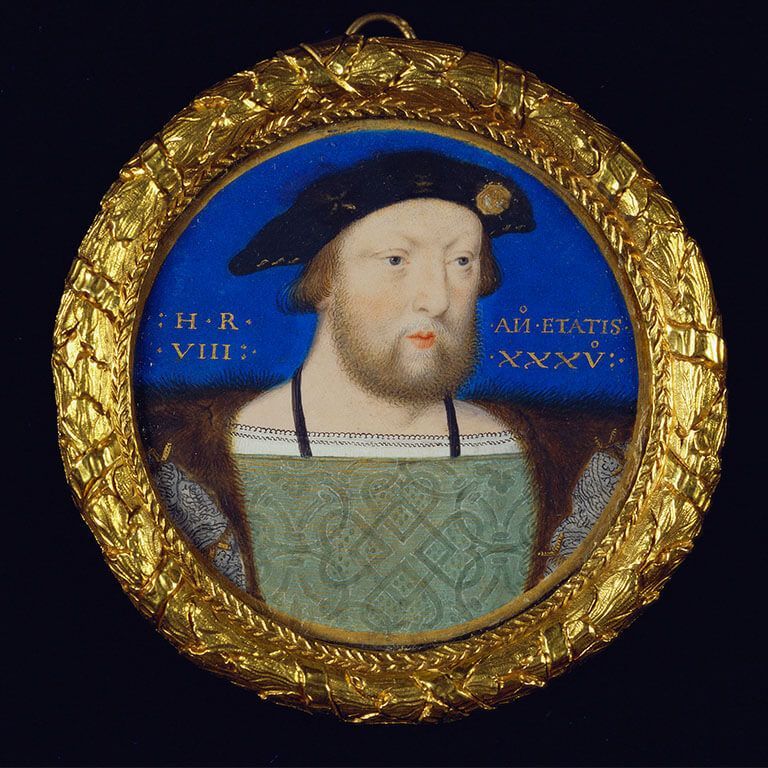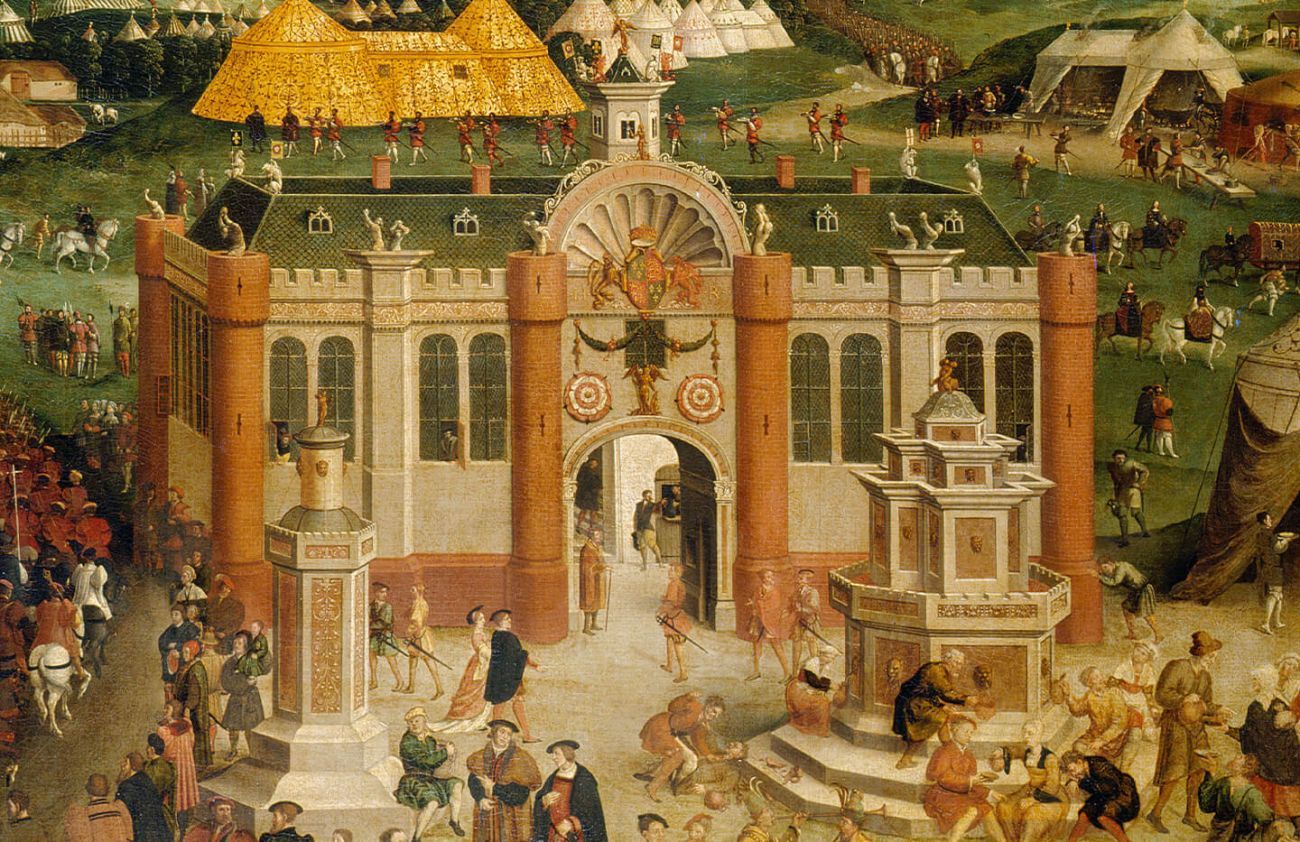- Story
- Tudors
All eyes on Henry
There ain't no party like a Tudor party
Forget leaking tents, bad barbecues, and queues for the portaloos. When Henry VIII throws a festival, he does it in style. Matthew Wood, Interpretation Officer, explores how Henry's plan to wow French King Francis I led to the Field of Cloth of Gold, which took place across 18 days, in June 1520.
Matthew shares some tips and tricks for creating your own Tudor festival, should you ever need to impress a king.
7 minute read
Think Like a King
It would be hard for most of us to prepare for a festival like Henry VIII did for the Field of Cloth of Gold in 1520. To make sense of the scale and the glamour of the occasion, you’ve got to think like a king. Put yourself in the shoes of Henry VIII. This is your big chance to show off! All eyes will be on you, watching to see what kind of European King you will be. The French King and the Holy Roman Emperor are both looking for a powerful ally. Will they find one in England? Or, heaven forbid, will they take one look at you and dismiss your kingdom as nothing more than an insignificant backwater? Best to not take any chances, so let’s plan an event that they’ll still be talking about in the year 2023.
Decide who to bring
It’s no good throwing a massive elaborate festival if all of your friends and family aren’t there to see it. It’s going to be such an ornate and lavish spectacle that should impress everyone at home as well as abroad. Anyone who is anyone back in England will want to come along to this, and it will be the same for the lords and ladies of France. If you’re anything like Henry VIII you’ll bring along 6,000 Dukes, Marquises, Earls, Lords, Bishops, Knights, Ladies, heralds, minstrels and servants. The French King Francis I matched Henry nobleman for nobleman, bringing 6,000 of his own entourage with him as well.
All of these Lords and Ladies were determined to look the part. One French guest at the time observed that the French noblemen came wearing their estates on their backs, meaning they’d mortgaged or sold parts of their lands to afford the finest clothes to wear at the Field of the Cloth of Gold. The French King Francis I even asked the French Ladies to arrive wearing the very latest Italian renaissance fashions, to impress their English counterparts. Ironically, the Italian ambassador criticised these dresses for being too provocative. We can only imagine how amazing and beautiful everyone must have looked, dressed in such outrageously expensive Tudor costumes.
Accommodation
12,000 very well dressed Lords, ladies and their servants are going to need a lot of accommodation. Where are you going to put them all? The answer for Henry VIII was to build a field of tents covering an area the size of Norwich, the second largest city in England in 1520. The English would stay in 820 tents and the French brought around 400 of their own. These lodgings were full to the brim with all the finest tapestries, jewels, plates and furs that the noblemen and women could bring with them. The French King Francis I erected a huge royal tent, filled with splendid finery, with astronomical decorations arrayed inside the roof. For servants and less distinguished guests, a further 2,800 tents were put up.
Not to be outdone, the English not only brought tents, but actually built an entire temporary palace. Imagine standing on the plain green in front of the palace, first thing you’ll notice is the gold gilded fountain, pouring out wine from its fonts. This fountain helped to keep the guests merry, and is just one way in which the 200,000 litres of wine, about four pints per person a day, is being served to the guests. One was topped with a statue of Bacchus, God of Wine, and the other with Cupid, ready to hit any young lovers with his arrow, perhaps after they’d enjoyed some of the wine first.
As you approach the entrance to the palace, you’ll notice that it is huge, about 100 metres in length on each of its four sides. The base is made of brick, reaching up to two metres in height. It is topped by a 10 metre high structure of wood and canvas, designed to resemble masonry, with oiled cloth stretched across the roof, painted to give the illusion of slates. Atop the turreted roof you can see statues resembling ‘…men of warre redie to cast great stones…’ and terracotta roundels similar to ones still visible at Hampton Court Palace today. But by far and away the most spectacular feature of the palace is its windows. As you walk into the courtyard of the palace you can’t help but notice the 5,000 feet of clear glass windows in gilded wooden frames that surround you.
Inside the temporary palace you will see a most luxurious scene. It feels like the royal palaces have been cleared out and brought to this one place, with all of the Kings fine tapestries, silk cloth hangings, green velvet, and gold embroidered pillows decorating the four separate chambers for King Henry VIII, Queen Catherine, Cardinal Wolsey, and Mary Tudor (Henry’s sister and one time Queen of France). The palace also has its own chapel, containing gold basins, a jeweled altar, golden candlesticks and a golden chalice, and a golden crucifix upon the altar. The Chapel is attended by no less than 35 priests. Beyond the chapel there is even a covered gallery that leads all the way back to Guînes castle, no mean feat considering it has to cross a moat to get there.
Food and entertainment
Now that you have arrived at the Field of Cloth of Gold with your 6,000 guests and wowed the 6,000 strong French crowd with your amazing temporary palace, it’s time to think about what you’ll be doing for the next two weeks together. You’ve got the wine sorted, and just in case that isn’t enough you’ve also brought along 66,000 litres of beer, with the equipment to brew more if you need it. Your guests will be expecting an extravagant feast, so you’ll need a lot of food and, as it is supposed to be entertaining, a lot of variety as well. The accounts of the royal household reveal that for the fish course alone Henry VIII provided 9,100 plaice, 7,836 Whiting, 5,554 Soles, 2,800 Crayfish, 700 Conga Eels, 3 porpoises and a dolphin. Nobody at the Field of the Cloth of Gold is going to go hungry.
But eating and drinking isn’t the only thing your guests will be doing. They’ll need entertainment! This means 18 days of jousting, horse combat and foot combat, apart from on Sundays of course, when you’ll be in the chapel. Both King Henry VIII and Francois I were young men, with a passion for sport. But remember, the Field of the Cloth of Gold was a grand spectacle of peace between two nations, so to save embarrassment the two kings never fought against one another. This worked well, despite Henry challenging Francis to an unplanned wrestling match, which he then lost.
If all that jousting, feasting and drinking just isn’t enough, you’ll need something to top it all off. How about a kite, in the shape of a dragon, flying over everyone’s heads, shooting off fireworks as it goes? This may sound incredible, but it happened at the Field of the Cloth of Gold in 1520. The kite, made by the English, of canvas stretched over wood, was designed to represent the symbolic emblems of the two kings; a salamander for Francois and a Welsh Dragon for Henry.
Pat yourself on the back
Hopefully, if you’ve followed these steps then you will have created one of the most memorable events of the 16th century. It certainly worked for King Henry VIII, as it made a lasting impression on people at the time, and it has certainly continued to capture people’s imagination over the last five centuries.






